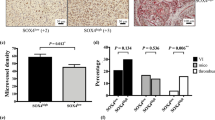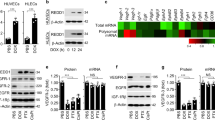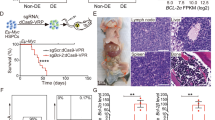Abstract
Dual-targeted therapy for antiangiogenesis and antilymphangiogenesis represents a potentially effective strategy for the treatment of various malignancies. Therefore, the goal of the present study was to identify genes that encode inhibitors of both angiogenesis and lymphangiogenesis. Using a cDNA library obtained from Lewis lung carcinoma (LL/2), a candidate gene was identified by the evaluation of growth inhibition in aortic and lymphatic endothelial cells (EC) as that coding for the mouse cold shock domain protein A (mCSDA). Overexpression of mCSDA significantly repressed cell proliferation and c-fos promoter activity in aortic, venous and lymphatic ECs. CSDA is a DNA-binding protein that binds to the hypoxia response element (HRE). Furthermore, of importance, we revealed that CSDA could directly bind to the serum response element (SRE) sequence, resulting in the inhibition of SRE activity, which may lead to growth inhibition in ECs. In an LL/2-inoculated mouse model, tumor growth was significantly repressed in an mCSDA-injected group. Histopathological analysis revealed that expression of blood and lymphatic EC markers was significantly decreased in mCSDA-injected groups. In conclusion, these data suggest that expression of CSDA can repress angiogenesis and lymphangiogenesis via direct binding to SRE in addition to HRE.
This is a preview of subscription content, access via your institution
Access options
Subscribe to this journal
Receive 50 print issues and online access
$259.00 per year
only $5.18 per issue
Buy this article
- Purchase on Springer Link
- Instant access to full article PDF
Prices may be subject to local taxes which are calculated during checkout









Similar content being viewed by others
Accession codes
References
Akagi K, Ikeda Y, Miyazaki M, Abe T, Kinoshita J, Maehara Y et al. (2000). Vascular endothelial growth factor-C (VEGF-C) expression in human colorectal cancer tissues. Br J Cancer 83: 887–891.
Bergers G, Song S, Meyer-Morse N, Bergsland E, Hanahan D . (2003). Benefits of targeting both pericytes and endothelial cells in the tumor vasculature with kinase inhibitors. J Clin Invest 111: 1287–1295.
Bunone G, Vigneri P, Mariani L, Buto S, Collini P, Pilotti S et al. (1999). Expression of angiogenesis stimulators and inhibitors in human thyroid tumors and correlation with clinical pathological features. Am J Pathol 155: 1967–1976.
Chilov D, Kukk E, Taira S, Jeltsch M, Kaukonen J, Palotie A et al. (1997). Genomic organization of human and mouse genes for vascular endothelial growth factor C. J Biol Chem 272: 25176–25183.
Coles LS, Diamond P, Lambrusco L, Hunter J, Burrows J, Vadas MA et al. (2002). A novel mechanism of repression of the vascular endothelial growth factor promoter, by single strand DNA binding cold shock domain (Y-box) proteins in normoxic fibroblasts. Nucleic Acids Res 30: 4845–4854.
Coles LS, Diamond P, Occhiodoro F, Vadas MA, Shannon MF . (1996). Cold shock domain proteins repress transcription from the GM-CSF promoter. Nucleic Acids Res 24: 2311–2317.
Diamond P, Shannon MF, Vadas MA, Coles LS . (2001). Cold shock domain factors activate the granulocyte-macrophage colony-stimulating factor promoter in stimulated Jurkat T cells. J Biol Chem 276: 7943–7951.
Folkman J . (1971). Tumor angiogenesis: therapeutic implications. N Engl J Med 285: 1182–1186.
Folkman J . (2006). Antiangiogenesis in cancer therapy—endostatin and its mechanisms of action. Exp Cell Res 312: 594–607.
Gragoudas ES, Adamis AP, Cunningham Jr ET, Feinsod M, Guyer DR . (2004). Pegaptanib for neovascular age-related macular degeneration. N Engl J Med 351: 2805–2816.
Hill CS, Wynne J, Treisman R . (1994). Serum-regulated transcription by serum response factor (SRF): a novel role for the DNA binding domain. EMBO J 13: 5421–5432.
Hurwitz H, Fehrenbacher L, Novotny W, Cartwright T, Hainsworth J, Heim W et al. (2004). Bevacizumab plus irinotecan, fluorouracil, and leucovorin for metastatic colorectal cancer. N Engl J Med 350: 2335–2342.
Izumi Y, Xu L, di Tomaso E, Fukumura D, Jain RK . (2002). Tumour biology: herceptin acts as an anti-angiogenic cocktail. Nature 416: 279–280.
Kaneda Y, Nakajima T, Nishikawa T, Yamamoto S, Ikegami H, Suzuki N et al. (2002). Hemagglutinating virus of Japan (HVJ) envelope vector as a versatile gene delivery system. Mol Ther 6: 219–226.
Kaplan RN, Riba RD, Zacharoulis S, Bramley AH, Vincent L, Costa C et al. (2005). VEGFR1-positive haematopoietic bone marrow progenitors initiate the pre-metastatic niche. Nature 438: 820–827.
Karpanen T, Egeblad M, Karkkainen MJ, Kubo H, Yla-Herttuala S, Jaattela M et al. (2001). Vascular endothelial growth factor C promotes tumor lymphangiogenesis and intralymphatic tumor growth. Cancer Res 61: 1786–1790.
Kim KJ, Li B, Winer J, Armanini M, Gillett N, Phillips HS et al. (1993). Inhibition of vascular endothelial growth factor-induced angiogenesis suppresses tumour growth in vivo. Nature 362: 841–844.
Kobori M, Ikeda Y, Nara H, Kato M, Kumegawa M, Nojima H et al. (1998). Large scale isolation of osteoclast-specific genes by an improved method involving the preparation of a subtracted cDNA library. Genes Cells 3: 459–475.
Kudo S, Mattei MG, Fukuda M . (1995). Characterization of the gene for dbpA, a family member of the nucleic-acid-binding proteins containing a cold-shock domain. Eur J Biochem 231: 72–82.
Lord BI . (1988). Feedback regulators in normal and tumour tissues. J Cell Sci 10 (Suppl): 231–242.
Mandriota SJ, Jussila L, Jeltsch M, Compagni A, Baetens D, Prevo R et al. (2001). Vascular endothelial growth factor-C-mediated lymphangiogenesis promotes tumour metastasis. EMBO J 20: 672–682.
Nakagami H, Maeda K, Morishita R, Iguchi S, Nishikawa T, Takami Y et al. (2005). Novel autologous cell therapy in ischemic limb disease through growth factor secretion by cultured adipose tissue-derived stromal cells. Arterioscler Thromb Vasc Biol 25: 2542–2547.
Nakagami H, Morishita R, Yamamoto K, Taniyama Y, Aoki M, Matsumoto K et al. (2001). Mitogenic and antiapoptotic actions of hepatocyte growth factor through ERK, STAT3, and AKT in endothelial cells. Hypertension 37: 581–586.
Niki T, Iba S, Tokunou M, Yamada T, Matsuno Y, Hirohashi S . (2000). Expression of vascular endothelial growth factors A, B, C, and D and their relationships to lymph node status in lung adenocarcinoma. Clin Cancer Res 6: 2431–2439.
Nishikawa T, Nakagami H, Matsuki A, Maeda A, Yo CY, Harada T et al. (2006). Development of high-throughput functional screening of therapeutic genes, using a hemagglutinating virus of Japan envelope vector. Hum Gene Ther 17: 470–475.
O'Reilly MS, Boehm T, Shing Y, Fukai N, Vasios G, Lane WS et al. (1997). Endostatin: an endogenous inhibitor of angiogenesis and tumor growth. Cell 88: 277–285.
Pepper MS . (2001). Lymphangiogenesis and tumor metastasis: myth or reality? Clin Cancer Res 7: 462–468.
Pike SE, Yao L, Jones KD, Cherney B, Appella E, Sakaguchi K et al. (1998). Vasostatin, a calreticulin fragment, inhibits angiogenesis and suppresses tumor growth. J Exp Med 188: 2349–2356.
Rikitake Y, Kawashima S, Yamashita T, Ueyama T, Ishido S, Hotta H et al. (2000). Lysophosphatidylcholine inhibits endothelial cell migration and proliferation via inhibition of the extracellular signal-regulated kinase pathway. Arterioscler Thromb Vasc Biol 20: 1006–1012.
Saito Y, Nakagami H, Morishita R, Takami Y, Kikuchi Y, Hayashi H et al. (2006). Transfection of human hepatocyte growth factor gene ameliorates secondary lymphedema via promotion of lymphangiogenesis. Circulation 114: 1177–1184.
Shannon MF, Coles LS, Attema J, Diamond P . (2001). The role of architectural transcription factors in cytokine gene transcription. J Leukoc Biol 69: 21–32.
Shannon MF, Coles LS, Vadas MA, Cockerill PN . (1997). Signals for activation of the GM-CSF promoter and enhancer in T cells. Crit Rev Immunol 17: 301–323.
Shimamura M, Sato N, Taniyama Y, Yamamoto S, Endoh M, Kurinami H et al. (2004). Development of efficient plasmid DNA transfer into adult rat central nervous system using microbubble-enhanced ultrasound. Gene Therapy 11: 1532–1539.
Skobe M, Hawighorst T, Jackson DG, Prevo R, Janes L, Velasco P et al. (2001). Induction of tumor lymphangiogenesis by VEGF-C promotes breast cancer metastasis. Nat Med 7: 192–198.
Sleeman JP . (2000). The lymph node as a bridgehead in the metastatic dissemination of tumors. Recent Results Cancer Res 157: 55–81.
Stacker SA, Caesar C, Baldwin ME, Thornton GE, Williams RA, Prevo R et al. (2001). VEGF-D promotes the metastatic spread of tumor cells via the lymphatics. Nat Med 7: 186–191.
Sund M, Hamano Y, Sugimoto H, Sudhakar A, Soubasakos M, Yerramalla U et al. (2005). Function of endogenous inhibitors of angiogenesis as endothelium-specific tumor suppressors. Proc Natl Acad Sci USA 102: 2934–2939.
Taniyama Y, Morishita R, Aoki M, Nakagami H, Yamamoto K, Yamazaki K et al. (2001). Therapeutic angiogenesis induced by human hepatocyte growth factor gene in rat and rabbit hindlimb ischemia models: preclinical study for treatment of peripheral arterial disease. Gene Therapy 8: 181–189.
Tsurusaki T, Kanda S, Sakai H, Kanetake H, Saito Y, Alitalo K et al. (1999). Vascular endothelial growth factor-C expression in human prostatic carcinoma and its relationship to lymph node metastasis. Br J Cancer 80: 309–313.
Watanabe K, Hasegawa Y, Yamashita H, Shimizu K, Ding Y, Abe M et al. (2004). Vasohibin as an endothelium-derived negative feedback regulator of angiogenesis. J Clin Invest 114: 898–907.
Yonemura Y, Endo Y, Fujita H, Fushida S, Ninomiya I, Bandou E et al. (1999). Role of vascular endothelial growth factor C expression in the development of lymph node metastasis in gastric cancer. Clin Cancer Res 5: 1823–1829.
Yoon YS, Murayama T, Gravereaux E, Tkebuchava T, Silver M, Curry C et al. (2003). VEGF-C gene therapy augments postnatal lymphangiogenesis and ameliorates secondary lymphedema. J Clin Invest 111: 717–725.
Zou W . (2005). Immunosuppressive networks in the tumour environment and their therapeutic relevance. Nat Rev Cancer 5: 263–274.
Acknowledgements
This work was supported by the Northern Osaka (Saito) Biomedical Knowledge-Based Cluster Creation Project and the Mitsubishi Pharma Research Foundation. We thank Prof. Hiroshi Nojima of Osaka University for technical assistance and advice in making cDNA library and Dr Gregory J Goodall of the Hanson Centre for Cancer Research, Institute of Medicine and Veterinary Science for providing the hCSDA plasmid.
Author information
Authors and Affiliations
Corresponding author
Additional information
Supplementary Information accompanies the paper on the Oncogene website (http://www.nature.com/onc).
Supplementary information
Rights and permissions
About this article
Cite this article
Saito, Y., Nakagami, H., Kurooka, M. et al. Cold shock domain protein A represses angiogenesis and lymphangiogenesis via inhibition of serum response element. Oncogene 27, 1821–1833 (2008). https://doi.org/10.1038/sj.onc.1210824
Received:
Revised:
Accepted:
Published:
Issue Date:
DOI: https://doi.org/10.1038/sj.onc.1210824
Keywords
This article is cited by
-
Rab37 Promotes Endothelial Differentiation and Accelerates ADSC-Mediated Diabetic Wound Healing through Regulating Secretion of Hsp90α and TIMP1
Stem Cell Reviews and Reports (2023)
-
Peptide P11 suppresses the growth of human thyroid carcinoma by inhibiting the PI3K/AKT/mTOR signaling pathway
Molecular Biology Reports (2019)
-
Validation of housekeeping gene and impact on normalized gene expression in clear cell Renal Cell Carcinoma: critical reassessment of YBX3/ZONAB/CSDA expression
BMC Molecular Biology (2014)
-
Cold shock domain protein A (CSDA) overexpression inhibits tumor growth and lymph node metastasis in a mouse model of squamous cell carcinoma
Clinical & Experimental Metastasis (2010)
-
Nuclear expression of the RNA-binding protein RBM3 is associated with an improved clinical outcome in breast cancer
Modern Pathology (2009)



